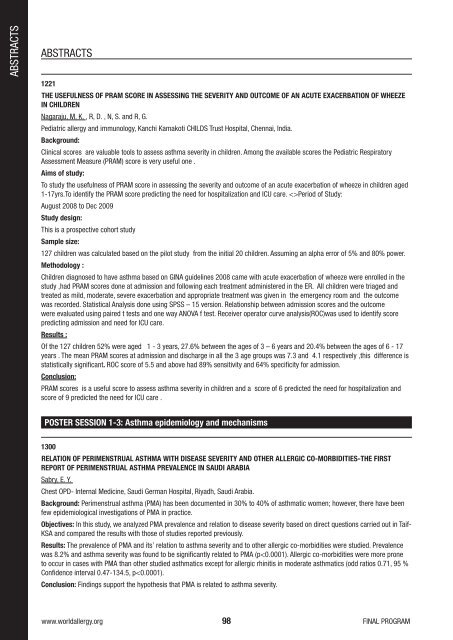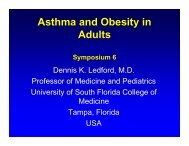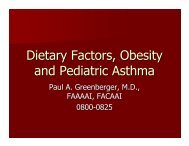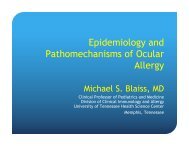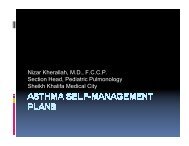Dubai Final-v20.indd - World Allergy Organization
Dubai Final-v20.indd - World Allergy Organization
Dubai Final-v20.indd - World Allergy Organization
You also want an ePaper? Increase the reach of your titles
YUMPU automatically turns print PDFs into web optimized ePapers that Google loves.
ABstrACts<br />
ABstrACts<br />
1221<br />
THE USEFUlnESS oF Pram SCorE in aSSESSing THE SEVEriTY anD oUTComE oF an aCUTE EXaCErBaTion oF WHEEZE<br />
in CHilDrEn<br />
nagaraju, m. K. , r, D. , n, s. and r, g.<br />
Pediatric allergy and immunology, Kanchi Kamakoti CHilDs trust Hospital, Chennai, india.<br />
Background:<br />
Clinical scores are valuable tools to assess asthma severity in children. Among the available scores the Pediatric respiratory<br />
Assessment measure (PrAm) score is very useful one .<br />
aims of study:<br />
to study the usefulness of PrAm score in assessing the severity and outcome of an acute exacerbation of wheeze in children aged<br />
1-17yrs.to identify the PrAm score predicting the need for hospitalization and iCU care. Period of study:<br />
August 2008 to Dec 2009<br />
Study design:<br />
this is a prospective cohort study<br />
Sample size:<br />
127 children was calculated based on the pilot study from the initial 20 children. Assuming an alpha error of 5% and 80% power.<br />
methodology :<br />
Children diagnosed to have asthma based on ginA guidelines 2008 came with acute exacerbation of wheeze were enrolled in the<br />
study ,had PrAm scores done at admission and following each treatment administered in the Er. All children were triaged and<br />
treated as mild, moderate, severe exacerbation and appropriate treatment was given in the emergency room and the outcome<br />
was recorded. statistical Analysis done using sPss – 15 version. relationship between admission scores and the outcome<br />
were evaluated using paired t tests and one way AnOVA f test. receiver operator curve analysis(rOC)was used to identify score<br />
predicting admission and need for iCU care.<br />
results :<br />
Of the 127 children 52% were aged 1 - 3 years, 27.6% between the ages of 3 – 6 years and 20.4% between the ages of 6 - 17<br />
years . the mean PrAm scores at admission and discharge in all the 3 age groups was 7.3 and 4.1 respectively ,this difference is<br />
statistically significant. rOC score of 5.5 and above had 89% sensitivity and 64% specificity for admission.<br />
Conclusion:<br />
PrAm scores is a useful score to assess asthma severity in children and a score of 6 predicted the need for hospitalization and<br />
score of 9 predicted the need for iCU care .<br />
PoSTEr SESSion 1-3: asthma epidemiology and mechanisms<br />
1300<br />
rElaTion oF PErimEnSTrUal aSTHma WiTH DiSEaSE SEVEriTY anD oTHEr allErgiC Co-morBiDiTiES-THE FirST<br />
rEPorT oF PErimEnSTrUal aSTHma PrEValEnCE in SaUDi araBia<br />
sabry, E. Y.<br />
Chest OPD- internal medicine, saudi german Hospital, riyadh, saudi Arabia.<br />
Background: Perimenstrual asthma (PmA) has been documented in 30% to 40% of asthmatic women; however, there have been<br />
few epidemiological investigations of PmA in practice.<br />
objectives: in this study, we analyzed PmA prevalence and relation to disease severity based on direct questions carried out in taif-<br />
KsA and compared the results with those of studies reported previously.<br />
results: the prevalence of PmA and its’ relation to asthma severity and to other allergic co-morbidities were studied. Prevalence<br />
was 8.2% and asthma severity was found to be significantly related to PmA (p


